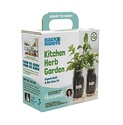There are so many wonderful herbs that can be grown in a garden, but here are the ones most commonly used, and easiest to grow. Keep in mind that most herbs need well-draining soil and plenty of sunlight. The herbs in this article are Mediterranean herbs, and therefore do not need to be watered as often. They also need to be free of pests and herbicides. Clean all herbs thoroughly before consuming. Herbs can also be dried and stored for later use.
Mint
It is one of the best herbs with the widest variety of uses. It can be used in teas, salads, desserts, or sauces. Mint is popular in many types of cocktails, such as mojitos and mint juleps. It can also act as a natural cure for indigestion, nausea, and headaches. When planted in the garden, it can be a natural deterrent for spiders.
If you decide to grow this in your garden, grow it in a large pot by itself. It grows rapidly, so plant it in a container that is at least twice as wide. It is invasive, so if you do plant it in a garden bed, plant it in a bottomless bucket set into the soil. This will keep it from spreading. To really help mint thrive in the garden, keep it moist, and water any time the leaves start to look wilted or run down.
Basil
Basil is one of the most popular herbs at any garden center. There are an overwhelming amount of varieties of basil, the most common of which is Sweet Basil. It is full of calcium and antioxidants. It is also high in fiber, and has a detoxifying effect on the liver.
Once established, it requires little maintenance. It does have a low tolerance for cold weather and should be brought indoors during colder months. Basil grows well indoors as long as it still gets enough sunlight. In the hotter months of summer, basil should only be watered every other day, if necessary. In order to better retain the flavor in the leaves, clip the buds if they begin to flower. Alternately, by keeping the blossoms, the smell is fresh and wonderful, and will attract pollinators.
Oregano
Also commonly called “wild marjoram,” this herb is very popular in Italian dishes. It is best known as the “pizza herb” for its tasty addition in marinara sauces on pizzas. It can also be used to flavor eggs, poultry, and bread. One word of advice when cooking with fresh oregano: be sure to add it last. It is quite delicate, and while the flavor is strong, the leaves do not hold up well if cooked on high heat for too long.
Oregano thrives in a hot, sunny environment. Its leaves and flowers are edible. Be careful to not overwater this herb, and check to make sure the soil is dry to the touch before giving it any moisture. In the winter months, protect the roots from frost to ensure that it makes a hearty comeback when the weather warms up again.
Dill
Dill used to be regarded as a cure for hiccups. While that may not be the case anymore, it is an herb full of antioxidants. It also has the ability to reduce cramps and swelling, and aid in digestion. It is the perfect herb to use with seafood or eggs, and goes nicely in soups or with potatoes.
It is grown best in full sun, although planting it in partial shade can keep it from flowering too quickly. It thrives in deep soils so that its roots have plenty of room to grow. It will attract helpful insects to your garden, such as wasps, but keep an eye on the leaves, as it also attract caterpillars.
Sage
Of all the herbs on this list, sage has the most medicinal properties. When made into tea, it can aid with anxiety, as well as enhance memory. It is an antiseptic, and contains antioxidants. It is said to help the body fight fatigue, and reduce fever. Supposedly it can also get rid of grey hairs (personally, this just seems unrealistic, but who can argue with science?). Sage is often paired with pork. One of the most unusual things about sage is that the bigger its leaf, the more flavor it will have.
It grows best in sunlight, with good soil and drainage. In the hotter months, it needs water every other day. The bees love the flowers. To retain the health and flavor, remove any branches that appear woody. It is also important to thin out sage in the spring, to let air flow through the plant and let sunlight into the base.


